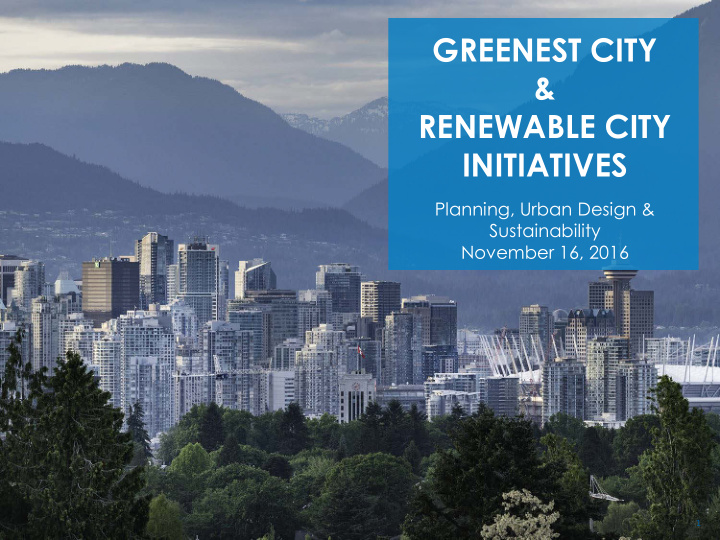



GREENEST CITY & RENEWABLE CITY INITIATIVES Planning, Urban Design & Sustainability November 16, 2016 1
RENEWABLE CITY STRATEGY (RCS) 2020 AND BEYOND In November 2015, City Council committed to achieving 100% renewable energy use before 2050. RENEWABLE CITY 2050 2020 2010 2030 2040 RENEWABLE CITY STRATEGY 2016 UPDATE 2
RCS 2016 HIGHLIGHTS RCS approved ~ November 2015 Zero Emissions Building Plan ~ July 2016 Engagement and education ~ ongoing RENEWABLE CITY STRATEGY 2016 UPDATE 3
PLAY VIDEO RENEWABLE CITY STRATEGY 2016 UPDATE 4
IN 2017 Renewable Energy Strategy for City Facilities VBBL Amendments for Energy Efficient Low-Rise MURBs Building Retrofit Plan Update RCS Implementation Plan RENEWABLE CITY STRATEGY 2016 UPDATE 5
TODAY EV Ecosystem Strategy Greenest City Fund Green Building Policy for Rezonings Update RENEWABLE CITY STRATEGY 2016 UPDATE 6
7
EV ECOSYSTEM STRATEGY Sustainability Group REPORT TO COUNCIL November 16, 2016
The Vancouver Context for EVs The EV Ecosystem The City’s Role and Approach 9
85% of Vancouverites purchasing a new car in the next 5 years plan on, or would consider, an EV. Icon made by Baianet from www.flaticon.com VANCOUVER CONTEXT FOR EVs 10
CITY POLICY CONTEXT » Renewable City Strategy » Greenest City Action Plan » Transportation 2040 » Healthy City Strategy EV charging infrastructure supports these areas VANCOUVER CONTEXT FOR EVs 11
OTHER LEADING JURISDICTIONS VANCOUVER CONTEXT FOR EVs 12
VANCOUVER’S CHARGING INFRASTRUCTURE 2007 EV Working Group 2009 Vancouver Building By-Law 2010 Project Get Ready 2011-2014 Charge & Go 2016 DC Fast Charge VANCOUVER CONTEXT FOR EVs 13
BARRIERS TO EV ADOPTION IN VANCOUVER Lack of home charging access Current network does not meet user needs Range < peak driving need Business risk Lack of vehicles VANCOUVER CONTEXT FOR EVs 14
OBJECTIVE Formalize the City’s role as a market incubator and as a provider of access to EV charging — a community amenity — over the next five years. VANCOUVER CONTEXT FOR EVs 15
Charging needs by Integrated and THE EV neighbourhood adaptable; part of ECOSYSTEM and building use City planning process; THE EV ECOSYSTEM 16
REMOVING BARRIERS Accessibility Affordability Economic Opportunity THE EV ECOSYSTEM 17
EV ECOSYSTEM STRATEGY SCOPE THE EV ECOSYSTEM 18
2016-2021 MARKET SUPPORT Five year strategy available and reliable with long-term view infrastructure THE CITY’S ROLE POLICY LEVERS OPTION TO EXIT Land-use and potential transition building policies to private sector THE CITY’S ROLE AND APPROACH 19
CITY AS MARKET Market without ACCELERATOR intervention EV SALES MARKET ACCELERATION There are only two vehicle lifetimes between now and 2050. TIME THE CITY’S ROLE AND APPROACH 20
LONG-TERM BUILD-OUT Market size (i.e., # customers) determines the business case for # STATIONS private sector deployment. PRIVATE CONNECTIONS PUBLIC STATIONS TIME THE CITY’S ROLE AND APPROACH 21
$ 3M over five years CAPITAL REQUEST THE EV ECOSYSTEM 22
BUSINESS CASE FOR PUBLIC CHARGING Private-sector uptake of Better ROI on public public charging Increase EV market charging infrastructure access to expansion charging Estimated # of EVs in Vancouver ~1,000 ~30,000 ~200,000 in 2016 by mid-2020s by 2050 Icon made by Baianet from www.flaticon.com THE CITY’S ROLE AND APPROACH 23 +’ve ROI
Expand access to home and APPROACH workplace charging Integrate EV Improve the infrastructure public charging planning into core network City processes THE CITY’S ROLE AND APPROACH 24 24
HOME AND WORKPLACE FLEXIBILITY AND SIMPLICITY VISIBILITY Expand EV charging Require specific, highly requirements visible labelling FINANCIAL SUPPORT ADVOCACY Develop incentive programs Provide certainty of access THE CITY’S ROLE AND APPROACH 25 25
PUBLIC CHARGING NETWORK INTEGRATED PLANNING FAIR AND AND FINANCING EXPANDED ACCESS EHub charging hubs Improved public Level 2 charging access and visibility THE CITY’S ROLE AND APPROACH 26 26
CORE CITY PROCESSES ENGINEERING SERVICES Operate City-owned network BUILDING AND DEVELOPMENT SERVICES Staff training on EV charging construction requirements PLANNING Develop guidelines for new public charging deployment THE CITY’S ROLE AND APPROACH 27 27
CAPITAL REQUEST $ 3M over five years EV ECOSYSTEM STRATEGY OUTCOMES $ 40M 117,000 tCO 2 e 20 - 25 40 fast charging Level 2 annual savings stations stations by mid-2020s THE CITY’S ROLE AND APPROACH 28 28
WHERE WE’RE GOING 2010 2020 2030 2040 2050 Regulatory changes; expand network; 4-8 DCFCs/year Affordable 300km+ range; “superfast” charging Increased revenue, ROI Residential charging, autonomous vehicles prevalent EV ECOSYSTEM 100% RENEWABLY POWERED STRATEGY TRANSPORTATION THE CITY’S ROLE AND APPROACH 29
NEXT STEPS NOVEMBER Final strategy to stakeholders Park Board ACES Working Group DECEMBER-JANUARY Regional Pricing Committee Quick Start actions THE CITY’S ROLE AND APPROACH 30
Questions? 31
Recommend
More recommend